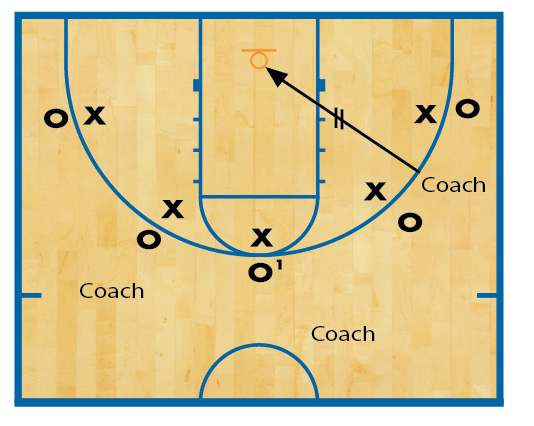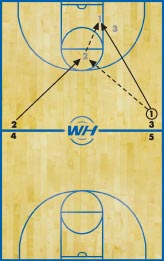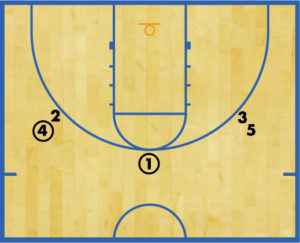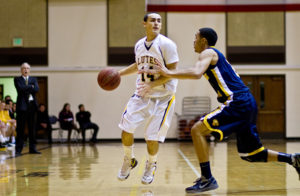‘Paint Drill’ ingrains hustle, aggressiveness
The Paint Drill is one that we use in the beginning of every practice to get things moving. It’s a very physical, fast-paced and intense drill that improves your players’ box-out ability, rebounding, outlet passing, defensive transition, fast breaks, and is a great conditioner.
Competition is fierce in this drill, yet your players will enjoy it. As with most drills, in order to get the most out of it, the Paint Drill must be run at game speed and under strict supervision by the coach.
Paint Drill
The drill begins with five offensive players (Os) lined up around the perimeter of the 3-point circle and paired off against five defensive players (Xs), who are lined up opposite each offensive player but inside the 3-point line. All players should be facing the basket.
It doesn’t matter where most position players line up, but your point guards (O1 and X1) must always stand at the top of the key. Three coaches or managers stand behind the groups of players each holding a ball.

If an offensive player (O) secures the board, he or she tries to put the ball back up and score. Tip-ins are not allowed. An offensive player must secure the rebound, land with both feet, and put up a strong power move to score. The offensive rebounder can use head fakes but must still go up aggressively with the put-back attempt.
DIAGRAM 1: To start the drill, one of the three coaches or managers randomly shoots and intentionally misses a jump shot. The offensive and defensive players must battle for the rebound.
Going up strong with the rebound gets your players used to game-like conditions for grabbing a rebound, putting up a shot, making the basket and drawing a foul for a 3-point play.
Transition work
If a defensive player gets the rebound, that player throws an outlet pass to a teammate on the wing and the Xs run a fast break to the other end of the court.
 DIAGRAM 2: Once the Xs begin their fast break, the Os must hustle back in transition and try to stop the score. If the Os stop the initial fast break, they must get back to defend the paint and set up into whatever type of zone or man defense you want them to apply. To improve team communication, have your point guard (O1) call out the defense during transition.
DIAGRAM 2: Once the Xs begin their fast break, the Os must hustle back in transition and try to stop the score. If the Os stop the initial fast break, they must get back to defend the paint and set up into whatever type of zone or man defense you want them to apply. To improve team communication, have your point guard (O1) call out the defense during transition.
If the Xs don’t score on the fast break, they run a secondary offensive attack until either they score or the defense gets completely set up. Coaches blow the whistle to stop play and they set up to run the drill again.
Run the drill to a set a number of scored points or have a set time limit as the goal. Whatever team has the most points at the end of the time limit wins. “Punish” the losing squad with a brief period of conditioning work, push-ups or sit-ups. While the losing squad is fulfilling their punishment, “reward” the winning squad with passing, shooting and free-throw shooting drills.
Since this is a warmup drill, keep the reward-punishment phase extremely brief and well organized.












